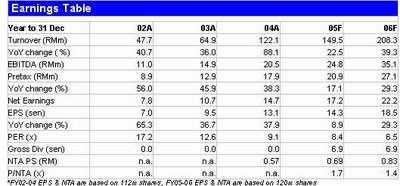BP Plastics
Monday, May 1, 2006
- BTW, i also happened to read BPPlastic annual report. It looks decent for me too. What is yr take here? High growth, ability to pass price to customer, no debt, cash is piling and 20%~40% return policy. Another under research comp????
So sorry.. missed this message of yours.
Actually I have in my old stuff some write-up (from iCap) on BP Plastics.
- Set up in 1990, BP Plastics (BPP) started its business in Batu Pahat by supplying polyethylene bags to the textile and garment industries. Since then, BPP has made significant progress to become a leading plastic film and bag packaging manufacturer.
With a current workforce of around 280 workers and operating 24 hours a day, 7 days a week, the group has a production capacity of 36,000 tonnes per annum. This capacity is split into 9,600 tonnes for blown plastic bags and 26,400 tonnes for cast stretch film, the two product groups of BPP. Crucial to the group’s past expansion plans was the purchase of a 2.5 meter width 5-layer cast stretch film machine in 2000, followed by a 4.0 meter width 7-layer cast stretch film machine in 2003. Together with the usage of advanced resins, these allowed BPP to produce high quality cast stretch film using sophisticated multiple layer technology. The quality is measured in terms of yield, strength, load retention and puncture resistance.
For the blown film, BPP produces plain and printed low density polyethylene (LDPE), linear LDPE, high density polyethylene and polypropylene bags, made according to the requirements of its customers. However, it is the stretch film division that has fuelled the growth of the group with sales of this division rising from almost zero in 2000 to over RM85 mln in 2004. Profit margins are higher for blown film while the printed bags generate higher margins than the plain bags do.
BPP has over 680 local and international customers. In 2004, direct exports constituted more than 55% of BPP’s sales. The major destinations for its cast stretch film are Japan, Singapore and Australia while Singapore, Indonesia and Australia form the largest markets for its blown film. Japan alone accounts for around 20% of its export sales. The exports are priced mainly in US$ with some in Yen and S$.
While the rise in resin prices has contributed to the rise in sales, this has affected the profit margin. The major cost item for the group is not surprisingly resin, forming about 60% of sales. The price of resin has risen from US$680 per tonne in early 2004 to more than US$1,000 by end 2004. While BPP is able to pass on the cost increase, it can only do so after a lag. In addition, the industry, both locally and regionally, is highly competitive. Despite this, BPP plans to expand further. A major portion of the RM9.6 mln proceeds from its public offering, together with more than RM17 mln from a prelisting rights issue, will be used to buy a 10-acre land in Batu Pahat, build a factory thereon and to purchase several pieces of machinery and equipment.
Well that I think should be the key issue for BP plastics. The rise in resin prices equates to higher expenses and from a business perspective, the business investor would be keen to know how well BP Plastics is able to pass the cost down to its customers.
Anyway, BP Plastics was listed on Feb 2005. So not much track record there is about this company except for the recent quarterly earnings it announced.
The following is a compiled table of BP Plastics quarterly earnings since its listing.
As can be seen, its last quarterly earnings is a concern. The operating margins and net profit profits is showing a sign of weakness. And the concern is if this is caused by the higher material costs..
However, it's first year total net earnings is 20.493 million. Which is signifcantly much higher than what it announced in its IPO prospectus (see announcement made to Bursa here ) and perhaps the following table from OSK gives a much clearer picture.

Now if one takes BP Plastics 02, 03 and04 numbers into consideration, then perhaps one could consider that BP Plastic is a high growth stock... but then some others would argue that those numbers 02, 03 and 04 should not be taken into consideration.
Total cash at 05 Q4 stood at 21.437 million, while total loans stood at 6.624 million. Pretty healthy I would suppose.
Dividends. BP has been a fair decent dividend paying stock. (see Interim Dividend, Interim Dividend and Final Dividend )
All in.. it looks decent.. but... perhaps it would more prudent to have a couple more quarterly earnings to see how BP Plastic copes with the higher resin prices.
Cheers!



0 comments:
Post a Comment